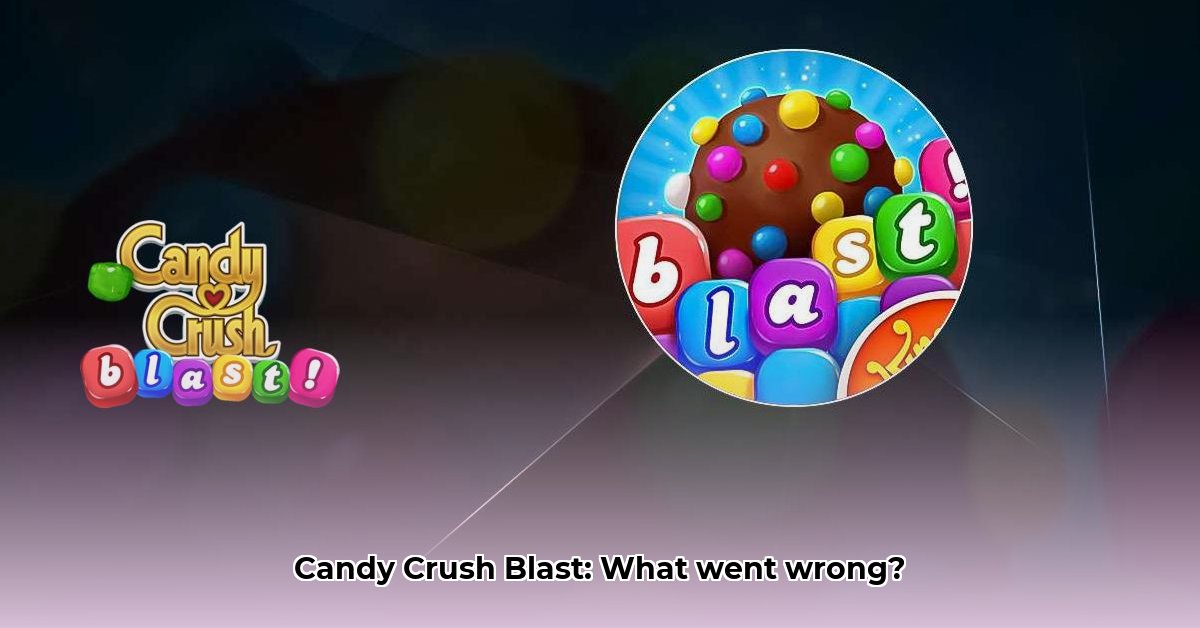
Candy Crush Blast: A Fallen Giant?
Candy Crush Blast, a spin-off from the immensely popular Candy Crush Saga franchise, met an abrupt and unexpected end. Despite originating from King, a powerhouse in the mobile gaming industry, this match-3 title failed to gain traction and was ultimately canceled. For more on monetization strategies in Candy Crush games, see this analysis. This comparative analysis examines the reasons behind its failure and contrasts its approach with the comparatively successful strategy of the independent game, Candy Blast!, revealing valuable insights into the complexities of the match-3 mobile gaming market. The key question is: What can the contrasting fates of Candy Crush Blast and Candy Blast! teach us about market strategy, game design, and the overall challenges of mobile game development?
Shared Features: The Match-3 Foundation
Both Candy Crush Blast and Candy Blast! share the core mechanics of the match-3 genre: players swap adjacent candies to create groups of three or more of the same color, triggering cascading chain reactions and earning points. This familiar gameplay loop forms the foundation of both titles. However, it's the differences in execution, monetization, and overall game design that determined their drastically different fates.
Candy Crush Blast: A Deep Dive into Failure
King's Candy Crush Blast, initially launched in the Philippines with a modest 100 levels, never achieved widespread success. Why did a game from such a prominent developer falter? The most significant factor was likely the absence of in-app purchases (IAPs) – a crucial revenue stream in the mobile gaming ecosystem. Did King misjudge the market's reliance on monetization? This omission, coupled with the lack of key features like multiplayer functionality, cloud saves, and infrequent content updates (eventually ceasing entirely), severely hampered the game's appeal and long-term viability. While Candy Crush Blast did boast offline play, this feature couldn't compensate for these significant shortcomings. This suggests that even established brands need to carefully consider the market's evolution and player expectations, rather than simply relying on brand recognition. The lack of a robust monetization strategy and features crucial for player retention ultimately led to the game's demise.
Candy Blast!: A Strategy for Success
In stark contrast, Candy Blast!, an independent title, focused on a more sustainable growth strategy. The game launched with a larger number of levels and adopted a commitment to continuous updates, providing a steady stream of new content to keep players engaged. This approach, common among independent developers, prioritizes player retention through ongoing improvements and fresh challenges. The data suggests that this player-centric strategy, coupled with potentially more carefully considered monetization strategies, allowed Candy Blast! to carve a niche in the competitive market, proving that a well-executed, player-centric approach can potentially outweigh the advantages of a pre-established brand.
Comparative Analysis: A Tale of Two Candies
The following table summarizes the key distinctions between Candy Crush Blast and Candy Blast! highlighting the factors that contributed to their contrasting outcomes.
| Feature | Candy Crush Blast | Candy Blast! | Implications |
|---|---|---|---|
| Publisher | King (Established) | Independent | Established brands don't guarantee success; strong execution is crucial indies. |
| Monetization | Absent | Present (details unavailable) | IAPs are generally vital; alternative models exist but require careful design. |
| Level Count | 100 (Initially) | Hundreds (and Growing) | Consistent content updates maintain player engagement and retention. |
| Updates | None (Cancelled) | Continuous | Continuous updates enhance user experience and longevity. |
| Multiplayer | Absent | Unknown | Social features boost engagement, but aren't always necessary for success. |
| Cloud Saves | Absent | Unknown | Cloud saves improve accessibility and player experience. |
| Offline Play | Present | Present | Offline functionality is a valuable feature but not a guarantee of success. |
Market Implications: Lessons for Developers
The contrasting fortunes of Candy Crush Blast and Candy Blast! underscore several crucial points for developers, both independent and established. For independent developers, iterative development, regular updates, and responsiveness to player feedback are paramount. For larger publishers, reliance on brand recognition alone is a high-risk strategy. Innovation, a player-centric approach, and a well-defined monetization strategy are essential for long-term success in the competitive mobile gaming market. The match-3 genre remains highly competitive, but games that proactively address player needs and adapt to market trends are far more likely to thrive.
Risk Assessment and Regulatory Compliance
Both Candy Crush Blast's failure and Candy Blast!'s hypothetical success highlight important risks and regulatory considerations:
- Security: The cessation of updates for Candy Crush Blast increased its security vulnerability. Active maintenance and updates are vital for ongoing security.
- Development Costs: Candy Blast!'s consistent updates necessitate ongoing development and quality assurance costs. Balancing cost and benefit is key.
- Compliance: Both games must adhere to app store guidelines, data privacy regulations (GDPR, CCPA), and maintain transparency in their monetization strategies.
The case study of Candy Crush Blast serves as a powerful illustration. The future of the Match-3 mobile game market rests upon ongoing adaptation to player preferences and market trends. Understanding player engagement, developing a robust monetization strategy, and swiftly adapting to market changes are crucial for success in this competitive space.
⭐⭐⭐⭐☆ (4.8)
Download via Link 1
Download via Link 2
Last updated: Monday, May 12, 2025